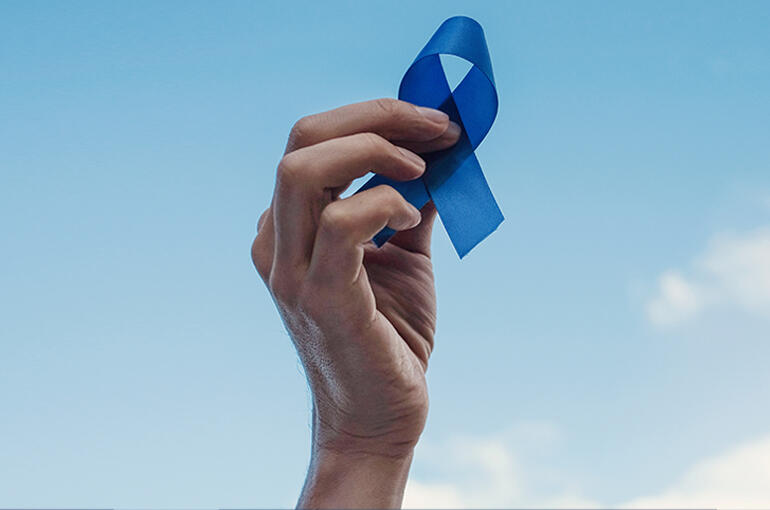Cancer de la prostate : il s’agit plus de bien vivre avec que du risque d’en mourir
19 novembre 2020

(Article en anglais) Maintaining a good quality of life with the disease requires early detection and appropriate treatment
Prostate cancer affects one in eight men over the age of 50, impacting their life over time. However, unlike with many other types of cancer, most men diagnosed with prostate cancer do not die from the disease. This being the case, the detection and appropriate treatment of prostate cancer is primarily aimed at ‘living better’ with the disease, rather than avoiding mortality. So, knowing this, how can men live ‘better’ with a prostate cancer diagnosis? The answer includes the fact that the earlier a cancer is detected, the more options there are to minimize the progression of the disease and reduce the impact it has on the quality of a man’s life.
Let’s start before prostate cancer is even detected. Maintaining a well-balanced diet, keeping one’s weight in check, reducing alcohol consumption and avoiding smoking, are all key to an overall healthy lifestyle. Regular exercise, while also a part of any wellness regime, has a specific benefit for prostate health. Prostate cancer reacts strongly to steroids in the body, and regular exercise helps to stabilize steroid levels by counterbalancing the ‘everyday’ stresses that flood the body with adrenaline.
However, despite maintaining a healthy lifestyle, genetics also play a role that should be considered. Men who have a first-degree relative (e.g. a father or brother) with prostate cancer are twice as likely to develop the disease, and there is also a generally heightened risk if a mother or sister has been diagnosed with breast cancer.
Understanding the warning signs is key. For example, any urinary disfunction exhibited after the age of 50 should be a signal to have a clinical visit with a urologist – these specialists are very adept at detection.
Normally, a clinical exam by way of a digital rectal examination should suffice to provide everything required for an initial diagnosis. Combining this exam with a simple blood test to detect PSA (prostate-specific antigen) can confirm the diagnosis and determine the extent of tumor growth. Given the low mortality risk of prostate cancer, doctors tend to monitor the aggressivity of the tumor with frequent PSA testing and ultrasounds, etc., before undertaking specific treatment. Depending on the progression of the disease and the age of the patient, several treatments are available to maintain quality of life.
Symptoms of prostate cancer

So, what does it mean to prioritize ‘quality of life’ or ‘living better’ with prostate cancer? Unfortunately, several of the treatment options have consequences that, while effective at removing the cancer, have negative impacts on the day-to-day life of a patient, including erectile dysfunction and urinary difficulties. Consequently, depending on the age of the patient and the progression of the disease, the ‘eradication’ of the cancer through full or partial removal of the prostate (prostatectomy) may leave a relatively young, early-stage patient with negative side effects that could last a lifetime. It could be said that the most recent ‘breakthrough’ in the treatment of prostate cancer is managing the medical mindset to spare patients from systematic surgery, by taking into account their day-to-day holistic quality of life and considering the full array of treatment options.
In the early stages, frequent monitoring for tumor progression using PSA testing and ultrasound may be all that doctors advise. This offers the patient a longer ‘normal/functional’ window before other interventions are advised. Unlike other cancers, where eradication is the immediate priority, the objective of most prostate cancer treatments is to delay the progression of the disease and offer the patient the best life possible.
In the later stages, the introduction of hormone therapy may be advised. This involves suppressing the level of testosterone on which the cancer cells feed. Steroid levels are quite important in this disease - the higher the levels, the worse the potential prognosis. So, if testosterone levels are very high, reducing them through treatment may have a positive patient impact. This treatment is effective at stopping growth and ‘choking off’ the cancer cells and offers the patient an ongoing good quality of life. Depending upon the extent of such treatment, which at the extreme includes full blockage of testosterone production (temporary chemical castration), there will be an impact on libido and erectile function, but neither side effect is permanent and will only exist during the period of treatment. This offers a patient with advanced disease windows of ‘normal life’ between treatments. One lasting side effect of hormone suppression therapy is a reduction in BMD (bone mass density), known as osteoporosis, often seen in women during menopause, yet this too is treatable.
In cases where the cancer has not spread beyond the prostate, or has spread only slightly, radiation therapy is quite effective at targeting and killing cancer cells. While a long-term side effect of this therapy is erectile disfunction, the impact is not immediate, and the patient can continue to have years of normal sexual function.
The debate on removing the prostate (prostatectomy) versus preserving the organ function stands as a major issue that is decided patient by patient, depending on the prognosis of the disease. Thanks to advances in robotic surgery, the procedure is now more precise, which reduces the risk of erectile and urologic disfunction. Other treatments such as radiotherapy may also be advised, when applicable to the patient’s level of cancer and taking into account the objective of preserving a ‘good life’ with the disease.
Insurance providers likewise need to take into account all the treatment options, as well as the general prognosis of a normal life expectancy in prostate cancer patients. The insured will be more likely to file claims related to reduced earning capacity due to working less, increased treatment expenses, and so forth. This is not, in most cases, a serious condition impacting life insurance claims.
In conclusion, given that most diagnosed prostate cancer patients will have a normal life expectancy, both the patient and the treating physician need to focus on how well the patient can live his life. Men need to pay attention to potential signals and visit their urologist if symptoms present themselves, especially after the age of 50. If a prostate cancer diagnosis is confirmed, it is important that the ‘stress’ of the word ‘cancer’ be tempered against what is likely to be a long life with the disease rather than a life cut short because of it.